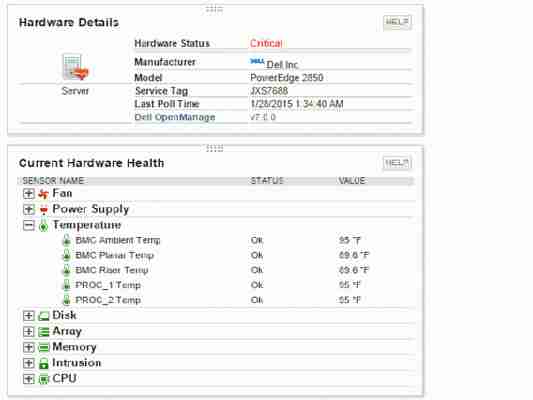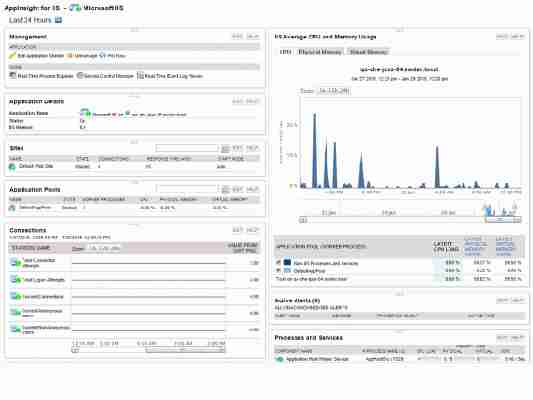Your website is the face of your business , connecting you to your customers and enabling you to complete transactions and provide services. Keeping it running smoothly is absolutely essential, and a crash or slowdown will mean losing customers.
While you’d probably think that your host provider has your back, the fact is, most hosting companies only send alerts in the aftermath of a crash, which is akin to having a fire alarm that only goes off when the building has completely burnt to the ground. You need to be able to recognize the telltale signs that your website is about to crash, and a good Performance Monitoring tool can make it dramatically easier for you to watch out for these symptoms.
In this article, we will be using the SolarWinds Server and Applications Monitor as an example of one such tool.
Here are some signs that your website is crashing and what you can do to avoid it:
Poor Performance
Whether it’s CPU or memory spikes, disk corruption or application failures, poor performance or even global Internet outages , a myriad of issues can cause your website to under-perform. While some of these issues are beyond your control, many others have symptoms that you can monitor for, and spot in time to take action or alert your host before it becomes a major issue.
Performance issues are probably the most difficult to triage. A slow website may be caused by a faulty hard drive on your server, or it could be the result of a software bug. Ruling out performance issues with your server should be the first step you take, and can easily be accomplished with your performance monitoring tool.
Let’s take a look at a hardware snapshot from the SolarWinds performance monitoring tool.

This is an example of server monitoring done right. Notice that the hardware components that are at risk of failing are flagged with red indicators. If this was your website, you could quickly call your host or your IT administrator and catch the problem before it becomes a disaster.
Difficulties Remote Controlling
Windows uses a service called Remote Desktop (RDP) to give you the ability to control your web server from anywhere in the world. RDP is important when you want to install new software on your server or when you need make new changes to your website.
RDP runs in the Windows background and when you make a “call” to the server, it responds with a login request. When performance wanes, you’ll notice difficulties with either RDP itself or navigating within the RDP window. Problems such as lockouts, application freezes, or dropped connections to the server are signs that something serious is happening and your website might be on a verge of a crash.
A good performance monitoring tool identifies the processes running on your server and gives you clues to identify which applications are taking too much memory or CPU resources. Take a look at the screenshot from the SolarWinds performance monitoring tool below.
Notice the section that indicates CPU usage. See the spikes? These spikes are normal, but too many spikes, or spikes that last too long, slow down the server and your website will eventually crash. Monitoring for these abnormalities means that you can schedule a server reboot to temporarily stop your website from crashing, and checking your monitoring log will help you perform a root-cause analysis.
 Notice the section that indicates CPU usage. See the spikes? These spikes are normal, but too many spikes, or spikes that last too long, slow down the server and your website will eventually crash. Monitoring for these abnormalities means that you can schedule a server reboot to temporarily stop your website from crashing, and checking your monitoring log will help you perform a root-cause analysis.
Notice the section that indicates CPU usage. See the spikes? These spikes are normal, but too many spikes, or spikes that last too long, slow down the server and your website will eventually crash. Monitoring for these abnormalities means that you can schedule a server reboot to temporarily stop your website from crashing, and checking your monitoring log will help you perform a root-cause analysis.Application Timeouts
Just like your personal computer, applications crash when your server’s resources are depleted. While a crash could simply mean that you need more resources, it could also be symptomatic of failing memory or a corrupted hard drive – both of which are difficult to diagnose without a performance monitoring tool.
Here is another SolarWinds example.
Notice that this SolarWinds tool displays all the applications that are running on the server, and it flags the applications that have failed to run. “Down applications” aren’t necessarily a bad thing as you can choose to keep some applications from running for various reasons. However, some applications could rely on these “down-ed” applications, which would result in website crashes or errors.
With a good monitoring tool such as SolarWinds, you can review the list of “down” applications that are affecting your system’s workflow and quickly restart these applications before a dramatic event happens.
Random Disconnects
Finally, a server that doesn’t have enough resources will have trouble handling your website’s visitor traffic. Let’s say about 1,000 people want to visit your website every day, and about 1% of these people eventually go on to buy something. Having a website that cannot accommodate all your traffic means it is possible that you might lose all 10 paying customers when trying to accommodate the 990 other people.
Your website server uses memory and CPU resources to respond to each of these users as they navigate throughout your website. Once these resources are used up, the website starts to refuse connections to new visitors. These disconnects would be represented in several ways -The loading icon spins indefinitely, the page loading incorrectly or incompletely, or a “Connection Refused” message appearing in the browser – none of which are part of a recipe for happy customers.
While server resources aren’t the only cause of random disconnects, it is the one thing that you can quickly check and rule out, before combing through countless logs and reports to find a software error.
Here’s an example of how SolarWinds uses a graphical representation to help you monitor user activity on your website to spot recurrent disconnection issues.
Looking at this list of running events, you can quickly identify if any user connections are returning an error.
Wrap up
A crashed website is probably one of the most catastrophic events that could happen to your business. Apart from lost customers and revenue, it impinges on your reputation of delivering your product or service reliably and professionally. Investing in a proper Performance Monitoring tool, such as SolarWinds Server and Application Monitor , could save you from buckets of tears and perspiration, and a potential crisis from boiling over.
